|
|
|
Sort Order |
|
|
|
Items / Page
|
|
|
|
|
|
|
| Srl | Item |
| 1 |
ID:
143925
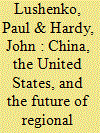

|
|
|
|
|
| Summary/Abstract |
The concept of order in regional security is often characterized as hierarchical, consensus-based, or some hybrid middle-road. The debate largely focuses on how major powers, specifically China or America, can individually build an accommodating order. This article explores the causation of order-building in reverse by asking if the Sino-US relationship can create order as a by-product of individual attempts to build and manage security. It examines Chinese and American responses to North Korea and the South China Sea to demonstrate that order can be constructed through a complex set of negotiated interactions, which encompass cooperative, hierarchical, and consensus-building approaches to order-building. This “unhappy coexistence” implies that order as a by-product of state interaction is a useful but incomplete framework to understand security order-building.
|
|
|
|
|
|
|
|
|
|
|
|
|
|
|
|
| 2 |
ID:
190876
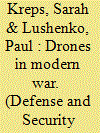

|
|
|
| 3 |
ID:
114616
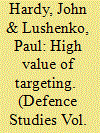

|
|
|
|
|
| Publication |
2012.
|
| Summary/Abstract |
There is a common theme in literature about High-Value Targeting (HVT): that it does not work. In order to make an informed judgment on the use of HVT in irregular war against networked opponents, an accurate analytical framework is required. This article proposes a conceptual model that recognizes HVT as: subordinate to strategic objectives, a shaping and enabling tool, rather than a decisive tool, and fuelled by a robust, intelligence-led targeting cycle. It identifies three methods of conducting HVT: pressuring, leveraging, and desynchronizing, and argues that there is a significant and underappreciated potential for complementarity between HVT and non-kinetic operations in irregular warfare.
|
|
|
|
|
|
|
|
|
|
|
|
|
|
|
|
| 4 |
ID:
165192


|
|
|
|
|
| Summary/Abstract |
In 2014, an affiliate of the Islamic State of Iraq and Syria emerged in Afghanistan. Wilayat Khorasan, or ISIS-K, intends to secure Afghanistan to legitimize the Islamic State’s caliphate across the ‘Khorasan Province’ including portions of Central Asia, China, Iran, the Indian Subcontinent, and Southeast Asia. While the group’s intent is clear, its capability confounds analysts. The authors argue that Wilayat Khorasan is likely the Islamic State’s most viable and lethal regional affiliate based on an expansionist military strategy. This is designed to enable the group’s encirclement of Jalalabad City in Nangarhar Province and is foundational to its expanded operational reach, regionalization, and lethality. Since 2016, the US-led Coalition’s counter-terrorism strategy has disrupted ISIS-K’s critical requirements and prevented external attacks. Yet, raids and strikes alone will not defeat ISIS-K. They must be calibrated against an institution-building approach that legitimizes Afghanistan’s government and redresses grievances that ISIS-K exploits to resolve.
|
|
|
|
|
|
|
|
|
|
|
|
|
|
|
|
| 5 |
ID:
144332
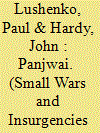

|
|
|
|
|
| Summary/Abstract |
The US Army has two approaches to counterinsurgency operations in Afghanistan. One is hard, or combat-focused, and the other is soft, or development-focused. This study examines two US Army task forces deployed to Panjwai District, Afghanistan from 2012 to 2013. CTF 4-9 and 1-38 offer a meaningful comparison because they pursued these contrasting approaches among the same population and against the same enemy at the same time and place. The study compares each unit’s approach and finds that neither approach was successful absent the other. The article concludes by recommending further research into combining the approaches at the operational level.
|
|
|
|
|
|
|
|
|
|
|
|
|
|
|
|
| 6 |
ID:
192030


|
|
|
|
|
| Summary/Abstract |
In “Will the Drone Always Get Through? Offensive Myths and Defensive Realities,” Antonio Calcara et al. examine whether emerging and disruptive technologies, namely unmanned aerial vehicles or drones such as the MQ-9 Reaper and TB-2 Bayraktar, change the offense–defense balance (ODB) in war. Their investigation of “current-generation” and “next-generation” drones—those with greater stealth and autonomy, for instance—nets two overall findings. First, the authors contend that the former “do not yield an offensive advantage against current-generation air defense systems.” Second, the authors “caution against taking for granted that next-generation drones will have an offensive advantage against next-generation air defenses.”Footnote1 This latter finding recognizes that air defense technologies are likely to evolve and compensate for advances in drone technology.
|
|
|
|
|
|
|
|
|
|
|
|
|
|
|
|
| 7 |
ID:
184080
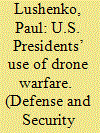

|
|
|
|
|
| Summary/Abstract |
Scholars often reduce America's use of drones to a bureaucratic process. While this enables them to recognise shifts in America's use of strikes since 2002, they cannot adequately explain such change over time. Rather, I argue that America's use of strikes is a function of presidents' decisions. Presidents adopt strategic and legal-normative cognitive frames that shape their decisions to use strikes. I use this typology to study crucial and pathway cases during the Obama and Trump administrations. I show that presidents' decisions to use drones are made to achieve state and social goals. The balance between these aims is informed by, and constitutive of, presidents' strategic and legal-normative frames. Understanding America's use of drones as a leader-driven practice suggests that the legitimacy of strikes may relate more to their impact on the relationship between norms and interests, and not the military or political nature of targets, as some ethicists claim.
|
|
|
|
|
|
|
|
|
|
|
|
|
|
|
|
|
|
|
|
|